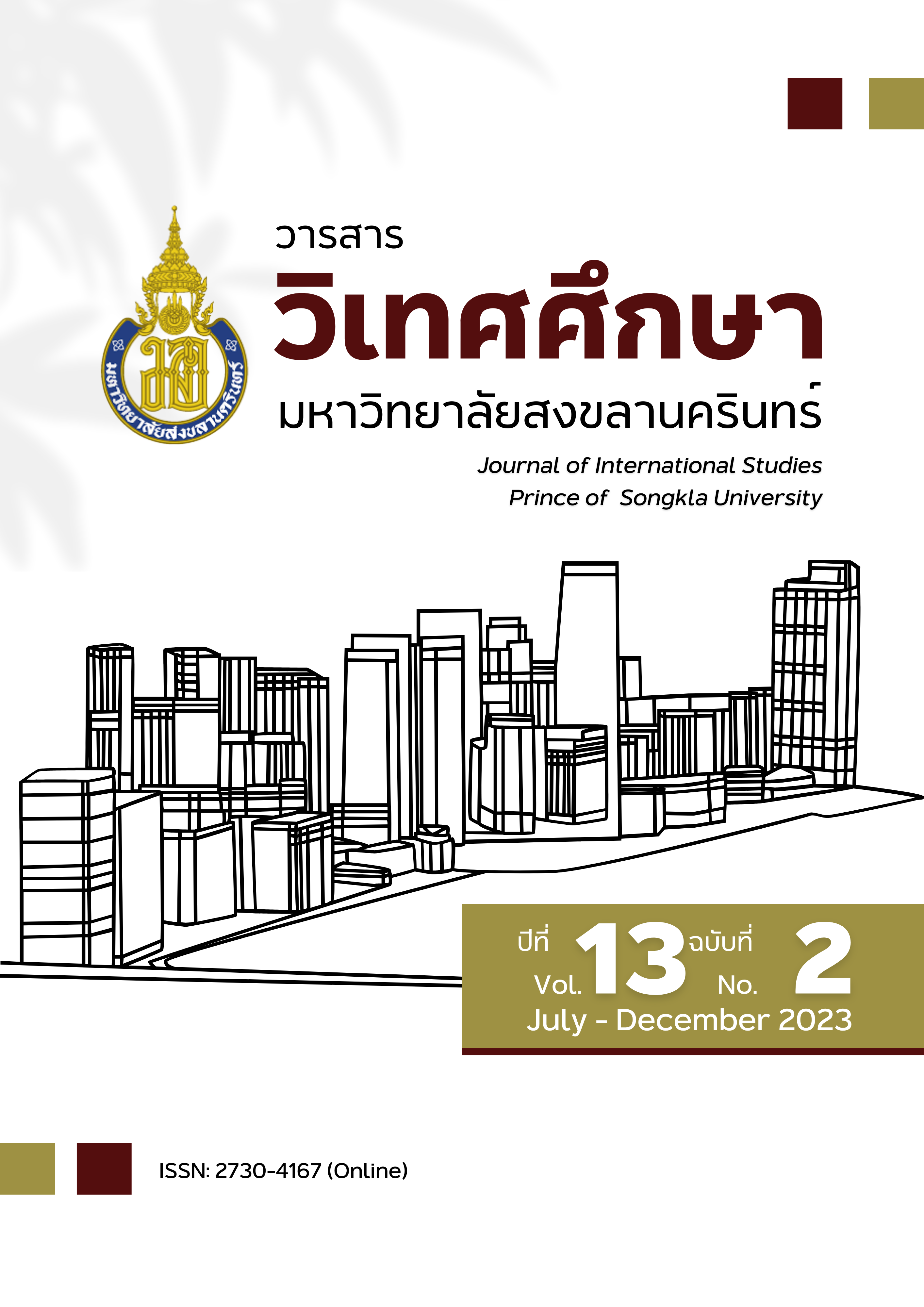การศึกษาการพึ่งพาวัฒนธรรมกวนซี่ของกลุ่มชาวจีนอพยพใหม่ในจังหวัดภูเก็ต
Main Article Content
บทคัดย่อ
งานวิจัยนี้เป็นงานวิจัยเชิงคุณภาพ มีวัตถุประสงค์เพื่อศึกษาการพึ่งพิงวัฒนธรรมกวนซี่ของกลุ่มชาวจีนอพยพใหม่ที่เข้ามาอาศัยอยู่ในจังหวัดภูเก็ต ประเทศไทย โดยสัมภาษณ์เชิงลึกผู้ให้ข้อมูลชาวจีนที่อาศัยอยู่ในจังหวัดภูเก็ตมาเป็นระยะเวลาไม่น้อยกว่า 12 เดือน จำนวน 10 คน ผลการวิจัยพบว่าแม้กลุ่มชาวจีนอพยพใหม่จะมีการติดต่อสื่อสารระหว่างกันบ้าง ช่วยเหลือซึ่งกันและกันและมีการตอบแทนซึ่งกันและกันบ้างตามโอกาส ซึ่งสอดคล้องกับลักษณะพื้นฐานบางประการของการพึ่งพิงวัฒนธรรมกวนซี่ แต่ปฏิสัมพันธ์ดังกล่าวยังไม่ลึกซึ้ง และกลุ่มตัวอย่างยังไม่เห็นความจำเป็นสำคัญของการพึ่งพาซึ่งกันและกันต่อการดำเนินชีวิตในจังหวัดภูเก็ต เนื่องจากกลุ่มชาวจีนอพยพใหม่ขาดความรู้สึกเป็นกลุ่มก้อน และมีช่องทางอื่นในการรับข้อมูลข่าวสารที่เพียงพอและน่าเชื่อถือที่สามารถช่วยแก้ปัญหาเฉพาะหน้าได้ อีกทั้งระบบกฎหมายของไทยให้ความคุ้มครองชาวต่างชาติมากขึ้นเมื่อเทียบกับอดีต และกลุ่มชาวจีนในปัจจุบันขาดความไว้วางใจซึ่งกันและกันเนื่องจากรู้จักกันเป็นระยะเวลาสั้น ๆ การพึ่งพิงวัฒนธรรมกวนซี่ระหว่างกลุ่มคนจีนจึงมีแนวโน้มลดลง
Article Details

อนุญาตภายใต้เงื่อนไข Creative Commons Attribution-NonCommercial-NoDerivatives 4.0 International License.
ข้อความและความคิดเห็นที่แสดงในบทความ เป็นแนวคิดของผู้เขียน มิใช่ความรับผิดชอบของกองบรรณาธิการ และคณะผู้จัดทำแต่อย่างใด
บทความ ข้อมูล เนื้อหา รูปภาพ ฯลฯ ที่ได้รับการตีพิมพ์ในวารสารวิเทศศึกษา ถือเป็นลิขสิทธิ์ของวารสารวิเทศศึกษา หากบุคคลหรือหน่วยงานใดต้องการนำทั้งหมดหรือส่วนหนึ่งส่วนใดไปเผยแพร่ต่อหรือเพื่อกระทำการใด ๆ จะต้องได้รับอนุญาตเป็นลายลักษณ์อักษรจากวารสารวิเทศศึกษา ก่อนเท่านั้น
เอกสารอ้างอิง
กองบรรณาธิการศิลปวัฒนธรรม. (2566). ชาวจีนอพยพใหม่ เหมือน-แตกต่าง จากชาวจีนโพ้นทะเลอย่างไร. ศิลปวัฒนธรรม. https://www.silpa-mag.com/history/article_67998
เธียรชัย เอี่ยมวรเมธ. (2548). พจนานุกรมจีน-ไทย ฉบับใหม่ (พิมพ์ครั้งที่ 14). รวมสาส์น.
วันจรัตน์ เคชวิลัย และนาฏกานต์ ดิลท์ส. (2566). การมีปฏิสัมพันธ์กับการสร้างอัตลักษณ์ของคนไทยเชื้อสายจีนในภูเก็ต. วารสารวิชาการนอร์ทเทิร์น, 10(1), 83-99.
Bao, J. (2005). Chinese in Thailand. In Ember, M., Ember, C.R., & Skoggard, I. (Eds). Encyclopedia of Diasporas (pp. 751-759). Springer.
Berger, R., Herstein, R., Silbiger, A., & Barnes, B. R. (2015). Can guanxi be created in Sino–Western relationships? An assessment of Western firms trading with China using the GRX scale. Industrial Marketing Management, 47, 166-174.
Blau, P. (1964). Exchange and Power in Social Life. Willey.
Chung, W.-K., & Hamilton, G. G. (2001). Social Logic as Business Logic: Guanxi, Trustworthiness, and the Embeddedness of Chinese Business Practices. In R. P. Appelbaum, W. L. Felstiner, & V. Gessner, Rules and Networks: The Legal Culture of Global Business Transactions (pp. 325-346). Hart Publishing.
Gold, T., Guthrie, D., & Wang, D. (2004). An Introduction to the Study of Guanxi. In T. Gold, D. Guthrie, & D. Wang, Social Connection in China: Institution, Culture, and the Changing Nature of Guanxi (pp. 3-20). Cambridge University Press.
Gu, F. F., Hung, K., & Tse, D. K. (2008, July). When Does Guanxi Matter? Issues of Capitalization and Its Dark Sides. Journal of Marketing, 72, 12-28.
Guitong Ma, ศุภการ ศิริไพศาล, และ อดิศร ศักดิ์สูง. (2561). วัฒนธรรมกวนซี่กับการสร้างเครือข่ายทางสังคมของชาวไทยเชื้อสายจีนฮากกาในพื้นที่ภาคใต้ตอนล่างประเทศไทย. อินทนิลทักษิณสาร, 13(2), 139-163.
Homans, G. C. (1958). Social Behaviour as Exchange. American Journal of Society, 63(6), 597-606.
Jiang, J. P. (1966, Mar). The Chinese in Thailand: Past and Present. Journal of Southeast Asian History, 7(1), 39-65.
Keister, L. A. (2004). Guanxi in Business Groups: Social Ties and the Formation of Economic Relations. In T. Gold, D. Guthrie, & D. Wank, Social Connections in China: Institution, Culture, and the Changing in Nature of Guanxi (2nd ed., pp. 77-86). Cambridge University Press.
Langenberg, E. A. (2007). Guanxi and Business Strategy: Theory and Implications for Multinational Companies in China. Physica-Verlag.
Lockard, C. A. (2013). Chinese Migration and Settlement in Southeast Asia before 1850: Making Fields from the Sea. History Compass, 11(9), 765-781.
Luo, Y. (2007). Guanxi and Business (2nd ed.). World Scientific.
McCurry, J., & Kollewe, J. (2011, February 14). The Guardian. https://www.theguardian.com/business/2011/feb/14/china-second-largest-economy
National Bureau of Statistics. (2021). Annual Data. https://data.stats.gov.cn/easyquery.htm?cn=C01&zb=A0M0A&sj=2021
Patranobis, S. (2013, February 18). Lack of trust between people plaguing Chinese society. Hindustan Times. https://www.hindustantimes.com/world/lack-of-trust-between-people-plaguing-chinese-society/story-YDp456MQzIbkUKZutIg2bP.html
Rae, I., & Witzel, M. (2008). Chinese of South East Asia: History, Culture, Business. Palgrave Macmillan.
Siriphon, A. (2015). Xinyimin, New Chinese Migrants, and the Influence of the PRC and Taiwan on the Northern Thai Border. In Y. Santasombat, Impact of China's Rise on the Mekong Region (pp. 147-166). Palgrave Macmillan.
Siriphon, A. (2019). Developing Entrepreneurship Under the Rise of China: Chinese Migrant Entrepreneurs in Tourism-Related Business in Chiang Mai. In Y. Santasombat, The Sociology of Chinese Capitalism in Southeast Asia (pp. 271-289). Palgrave Macmillan.
Skinner, W. G. (1957). Chinese Society in Thailand: An Analytic History. Cornell University Press.
Sng, J., & Bisalputra, P. (2015). A History of the Thai-Chinese. Edition Didier Millet.
Suryadinata, L. (2017). The Rise of China and the Chinese Overseas: A Study of Beijing's Changing Policy in Southeast Asia and Beyond. ISEAS Publishing.
Textor, C. (2022, December 6). Selected countries with the largest number of overseas Chinese 2021. Statista. https://www.statista.com/statistics/279530/countries-with-the-largest-number-of-overseas-chinese/
Textor, C. (2023, May 1). Per capita gross domestic product (GDP) in China in 2022, by province or region. Statista. https://www.statista.com/statistics/1093666/china-per-capita-gross-domestic-product-gdp-by-province/
Macroeconomics. (2023, April 28). BOI. https://www.boi.go.th/index.php?page=macroeconomics
Wang, G. (2000). The Chinese Overseas: From Earthbound China to the Quest for Autonomy. Harvard University Press.
World Bank. (2022). GDP per capita (current $US) - China. https://data.worldbank.org/indicator/NY.GDP.PCAP.CD?locations=CN
Yu, S., & Hale, T. (2021, December). China fights a financial fraud explosion. Financial Times. https://www.ft.com/content/77f61cf0-5b9d-4ea8-854a-4f220039dcb7


